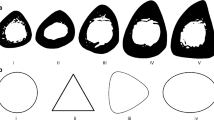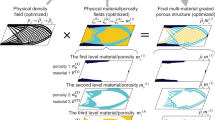Abstract.
Bones do not normally fracture near blood vessel holes. This in part may be related to spatial distribution of porosity, mineralization, and microstructure observed near the holes, as these parameters are known to affect bone stiffness and strength. Material parameters representing physical variables are optimized in this paper using a simple two-dimensional model of the bone in an attempt to duplicate the observed material distributions. The objective is to minimize the failure index defined (stress-strength ratio) under a given uniaxial load. In addition to tailoring the elastic properties (by changing porosity and mineral density), and orthotropy (via optimizing material orientation) the study also investigates the effect of the shape of the hole. Of the three variables, shape was the most effective in minimizing the failure index, followed by tailoring of the elastic properties and lastly material orientation. The elastic modulus distribution in the optimum design was similar to that observed around foramen holes in bones. The contributions of the physical variables in minimizing the failure index were almost independent of each other. The optimization was able to reduce the failure index compared to a hole in a homogeneous plate but was not sufficient to prevent failure at the hole. This can be attributed to the limitations of the shape functions used to describe the spatial distribution of mineralization and volume fraction and limitations in models used to relate composition and microstructure to elastic properties. The shape functions used to describe the spatial distribution of mineral mass fraction and volume fraction and the constraints imposed on them resulted in a non-convex design space.
Similar content being viewed by others
Author information
Authors and Affiliations
Additional information
Received October 17, 2001 Revised manuscript received February 2, 2002
Rights and permissions
About this article
Cite this article
Venkataraman, S., Haftka, R. & Rapoff, A. Structural optimization using biological variables to help understand how bones design holes. Struct Multidisc Optim 25, 19–34 (2003). https://doi.org/10.1007/s00158-002-0268-1
Issue Date:
DOI: https://doi.org/10.1007/s00158-002-0268-1




